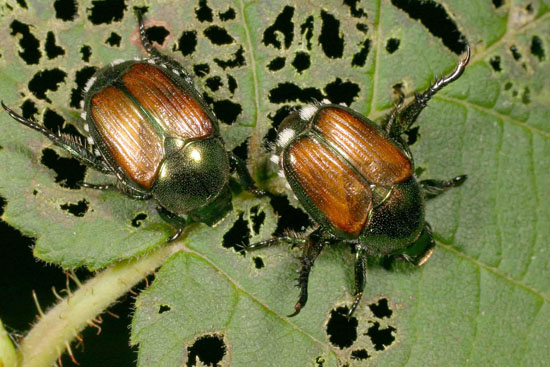Issue 12, July 20, 2015
Japanese Beetle
Japanese beetle adults are present throughout the state. In most areas, numbers are low, but there have been reports of locally high numbers. We continue to see low numbers in east central Illinois from Onarga south to Charleston and west to at least Monticello. This area continues across central Indiana and most of central Ohio. Research studies have discovered no reason for the lower numbers over the past several years.

Japanese beetle adults on grape leaf.
Numbers of Japanese beetles in central and northern Illinois were greatly reduced by deep soil freezing in the winter of 2013-2014 causing heavy white grub mortality. The droughts during the summer of 2012 and the second half of the summer of 2013 greatly reduced white grub numbers throughout the state. Although building in numbers, these events are probably the main causes of lower Japanese beetle larva and beetle numbers for the last couple of years.
Japanese beetle white grubs prefer moist soils, so they will prosper with the high rainfall we are experiencing across the state this spring and summer. Even so, the combination of low adult beetle numbers to lay eggs combined with the high soil moisture allowing roots to regrow from grub feeding should reduce the need for white grub preventative applications this year.
Spot treatment of locally high grub numbers is likely, but widespread insecticide application should not be needed this summer. Scout turf areas in early August for grubs, and treat areas with at least 10-12 white grubs per square foot. Trichlorfon (Dylox) and chlorantroniliprole (Acelepryn) provide high levels of control within 3-5 days after application, making them excellent rescue treatments. Obvious turf damage is unlikely to appear before late August, so scouting and treatment in the first half of August will prevent damage in those areas with high grub numbers. (Phil Nixon)
Author:
Phil Nixon